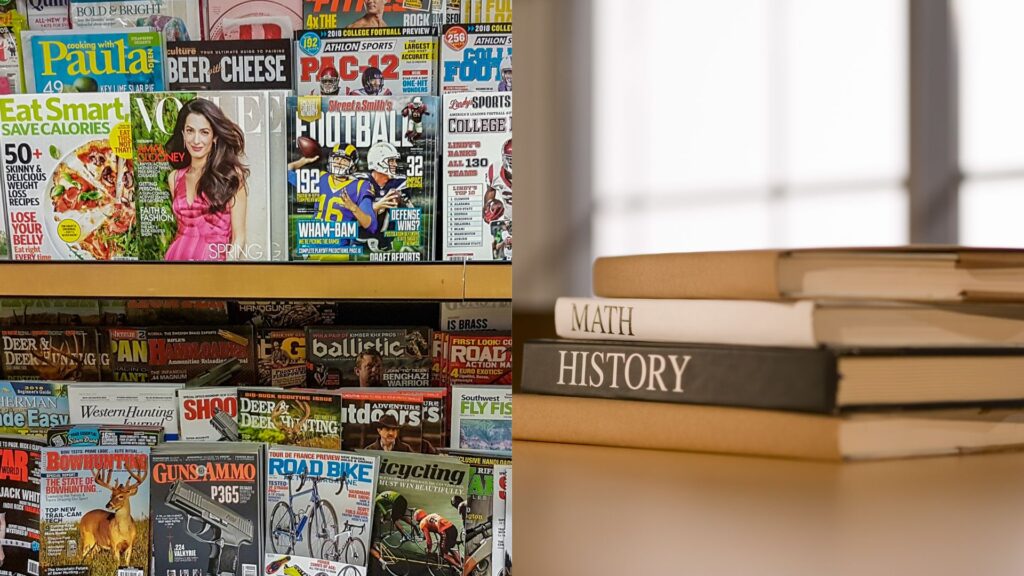Many people want to keep themselves updated with the daily news, events, politics, and developments. Most of the time, they need clarification while choosing between a magazine and a journal. So This article talks about some fundamental differences between magazines and journals.
Periodicals come in two different varieties: journals and magazines. The breadth of journals is more comprehensive than that of magazines. Journals can refer to academic journals, personal journals that provide information about one’s study, scholarly journals, etc. However, in everyday speech, we use the word “journals” to refer to academic and scholarly journals.
A magazine is a publication released regularly, such as weekly or monthly. It typically contains various articles, stories, and features on different topics of interest to a general audience. Magazines can be found on many subjects, such as news, entertainment, fashion, health, and more. Journals are meant for a specialized audience and cover specific subject areas.
The general qualities listed below can be used to distinguish between scientific journals and popular periodicals.
What are the Main Differences Between a Magazine and a Journal
1. Intent

Magazine:
Since the 1700s, magazines have been used as a form of literary publication to disseminate news and information relevant to a broad or niche target audience. Consumer magazines fall under the category of general interest publications and offer content for all readers.
In a consumer magazine, topics including news, business, fashion, celebrity life, entertainment, and men’s or women’s lifestyles are sometimes covered in one issue.
Journal:
Journals disseminate the findings of research in the subject matter they cover. They result from an organized, in-depth investigation of a particular subject, frequently comprising surveys or experiments.
Review articles and book reviews that synthesize the current body of knowledge on a topic may also be published in research journals.
2. Presentation

Magazine:
Magazines are often printed on glossy or semi-glossy paper in full color. Magazine covers will capture a reader’s attention since they are polished and appealing and frequently feature highlights of essential topics.
Numerous product advertisements often appear in magazines. Promotions could be for anything, including computers, cars, or cosmetic products. Some advertisements may fill an entire page or even span many pages when used as an insert or supplement.
Journal:
Journals need the fancy advertising, coupons, classified advertisements, etc., you get in famous publications. Like books, articles are frequently printed one column to a page and often include graphs, tables, or charts that allude to particular points made in the text.
3. Material

Magazine:
Magazines may cover a wide range of topics or concentrate on a single issue. For instance, publications like Time and Newsweek will cover various topics, including politics, entertainment, art, and music. For example, articles may mention research conducting in medicine, but they may need to go into greater depth about it.
While magazines like Car and Driver and Popular Science may concentrate on a specific topic, the articles they publish are more aimed at the general reader or those with a lingering interest in the subject than at academics and researchers.
Journal:
A journal is a compilation of content regularly publishing annually (much like a magazine). Journal articles are produce by professionals for experts and highlight the most recent findings. They might be in printed, published online, or both.
4. Audience

Magazine:
A magazine’s target audience is centered on a specific demographic. These can be adults, adolescents, kids, or males. Usually, they have something in common, such as a love of reading, running, or soccer. Personas can assist advertising in researching relevant magazine titles or trade journals.
Journal:
A journal is a publication written by academics with a primarily academic target audience. The journal has in-depth analysis, often focused on one discipline or educational topic, and is intended for professional or academic researchers.
It will go through peer review or refereed review by outside reviewers. A professional organization or an academic press needs to be the publisher.
5. Writer

Magazine:
Since magazines entertain content in various niches, many authors of different genres submit their respective works to be published in a magazine. No particular qualification is require to submit writing for a magazine.
Journal:
Most people who write journals are:
- Either highly qualified professionals.
- Vivid knowledge holders in a particular field.
- Scholars who share their vast knowledge through these journals.
6. Language

Magazine:
A magazine article’s language may be straightforward and informative or poetic to convey its theme, depending on its goals and intended audience. A magazine article can be conversational; the readership will determine how formal or casual your writing is. The article will be more engaging and have a more conversational tone.
Journal:
A journal’s tone is often formal; therefore, it shouldn’t sound informal or chatty. The use of colloquialisms, idioms, slang, phrasal verbs, and journalistic terms should be avoided because they are frequently imprecise and subject to misunderstanding.
The main goals of your language should be to explain and analyze knowledge from theories and/or research findings and to persuade readers that your interpretation of the theoretical knowledge and/or research findings is reasonable or justifiable. Your language should be more formal than everyday language.
7. Proofreading

Magazine:
Magazines usually don’t contain challenging or in-depth research about a subject, so during the proofreading process, all it needs is a basic fact check which can be done even by editors who need to learn about the particular topic they are editing.
Journal:
Getting your research paper professionally proofread if you are writing a research journal is advised. To ensure that your research paper achieves its maximum potential and boosts your chances of having it published in renowned publications, you must utilize expert research paper proofreading services.
8. Bibliography and References

Magazine:
Magazines include content provided by various individuals, and that content isn’t necessarily borrowed from another source, so it doesn’t always require mentioning bibliographical references.
Journal:
Journals are strictly fact-based research done by highly academic scholars, so it is of the utmost importance in a journal that references must be mentioned.
9. Examples

Magazine:
Some common examples of magazines are as follows:
- India Today
- Reader’s Digest
- Forbes India
- Cosmopolitan
- Filmfare
- Vogue
- Birds & Blooms
Journal:
Some common examples of journals are as follows:
- The New England Journal of Medicine
- PLOS One
- Annual Review of Psychology
- Journal of Clinical Oncology
- JAMA
- Journal of the IEST
- Journal of American Chemical Society
The following table sums up the differences between a magazine and a journal:
| S.No. | Criteria | Magazine | Journal |
| 1. | Intent | Entertainment, possibly including common knowledge | Academic knowledge exchange and peer recognition |
| 2. | Presentation | Attractive presentation, advertisements, a lot of illustrations, Shiny paper | Serious and sober Graphs or charts that are included to support the research No glossy pages or pictures will be present. |
| 3. | Material | Contains secondary reports or discussions, personal accounts, judgments, and anecdotes may also be present | includes a piece of thorough information, novel research, or an experiment |
| 4. | Audience | general public target | target audience: academics, researchers, and students |
| 5. | Writer | Depending on the article’s subject matter, anyone may submit an article | The majority of the time, respected academics or scholars |
| 6. | Language | for the general population, layman | Academic writing almost certainly uses specialist language or jargon |
| 7. | Proofread | It will likely be edited or proofread by a person who may or may not have an understanding of the article’s subject, basic fact-checking | Peer proofing is the process of having other members of the community examine and review the papers to make sure they are error-free and accurately represent the science at hand. Thorough fact-checking and proofreading may even conduct more trials to confirm the validity |
| 8. | Bibliography & References | It might or might not be provided | Must be given |
| 9. | Examples | National Geographic, Sports Illustrated | History of Education Quarterly, Journal of Education Finance |
Conclusion| Difference Between Magazine and Journal
Journals are written in a technical language and are primarily intended for researchers and subject-matter specialists, whereas magazines are written in a non-technical language and are intended for a broader audience. Although both journals and magazines are periodicals, journal articles and magazine articles differ significantly in ways like the one indicated above.
Really hoping it was helpful!
Also, feel free to have a look at:




